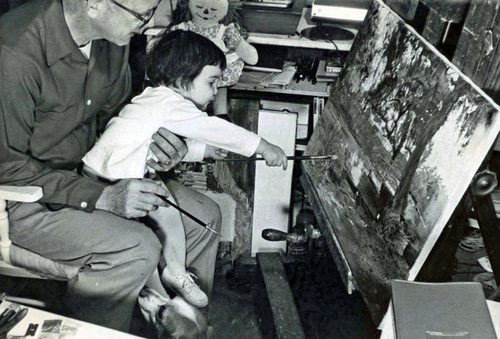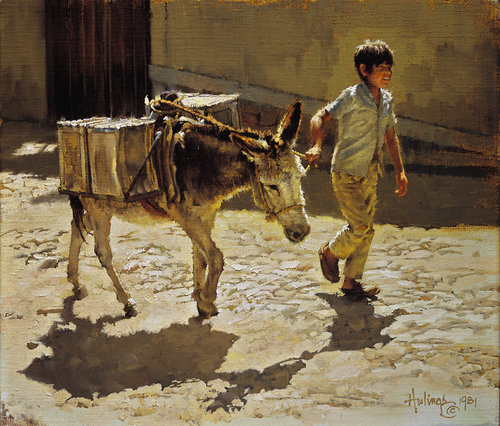by Carolyn Edlund
How important is a plan for your art career to outlive you?

The artist Clark Hulings and his daughter Elizabeth, age 2, shown in 1969. Painting shown is “The Spanish Moss Gatherer” oil, 21″ x 34″
Clark Hulings (1922-2011) was an American realist painter internationally recognized for his masterful technique, a penchant for capturing street scenes and marketplaces throughout Europe and Mexico, and for his signature depictions of donkeys in many of his works.
Although the artist passed away almost ten years ago, his legacy has survived him in a number of ways. His original paintings are sought after by collectors. Reproductions of his art are available to new fans who want to own his work. A museum retrospective is in the planning stage. And a nonprofit organization bearing his name is providing art business training to artists who want to take control over their businesses and their future, much as he did.
This is not by accident.
Elizabeth Hulings, the artist’s daughter, manages his estate and his legacy. She came by this role early on. Hulings explained, “I started working with my father at the age of 15, spending an entire summer cataloging his source material. He had hundreds of categories of subject matter that he used as reference for his compositions.”
In 2000, after the artist’s first one-man show in 23 years, she got involved in the business side of his art career, and worked closely with him until his death. “I was already in the business before he died, and I continue to manage all aspects of the estate today: maintaining the archives and catalogue and studio, tracking market activity and provenance, working with dealers to promote secondary sales, creating and selling giclees and other reproductions, etc.” Currently, she and her team are supporting the upcoming sale of eight of her father’s paintings at the Scottsdale Art Auction.

“Boy Leading Water Burro” 12″ x 14″ oil, 1981, by Clark Hulings
Elizabeth Hulings also acts as a legacy consultant for others. She helps artists, heirs and estate managers undertake preparation and steps to preserve legacy for historical reasons as well as to cultivate collectors well beyond the artist’s lifespan.
“When you die, you leave stuff behind,” she said. “It’s irresponsible not to make provisions for it. When you’re an artist, it is doubly irresponsible because you have spent all of this time creating and expressing a vision that matters to you. If you don’t take the time and put in the effort necessary to make provisions for that, then your life’s work is for naught.”
Planning isn’t only for established mid-career artists and beyond, however; it starts long before that point. “It is not arrogant or egotistical to plan,” advised Hulings. “When you are 20 years old making work, and you think ‘Who am I to assume my work will ever be worth anything?’ sign it anyway. Plan to be successful – it is your obligation.”
Artists should also discuss this planning with others who can help bring it to fruition. “You should make it so your family or assistant who deals with your work has the ability to carry out your wishes,” she said. “You cannot assume your relatives will care, or take action to deal with your art, and it’s not right to burden them with a disorganized studio.”
An artist’s estate, when run properly, can:
- Authenticate whether a particular piece is the work of the artist
- Create a catalog raisonne, which is a complete catalog of your life’s work
- Follow the secondary market and keep track of prices
- Propose museum shows and retrospectives to keep your work in the public eye
- Offer appraisal services to people who own your art
- Direct collectors to places where your work is coming up for sale or auction
- Manage licensing contracts
- Make sales of originals and reproductions of your art directly from the estate
Artists can proactively engage in their own legacy planning by:
- Making sure that you sign all of your artwork
- Keeping photos of everything you make. It’s easy with a cell phone – just document everything for posterity and identification
- Keeping records of all collectors who buy your work, including sales through galleries if possible
- Staying current on your CV. What awards have you won? What exhibitions have shown your work? What press have you received? What private and corporate collections include your art?
- Storing everything in an organized fashion where others can access it
- Making your wishes known concerning the disbursement, donation or sales of art in your estate, and other directives
“These activities are part of recording and documenting your career and experiences as an artist over time. Everything you save and share with your family, attorney or assistant will be useful in managing your estate,” said Hulings. “You can imagine how much easier it will be for an heir or executor who can put their hands on vital information that you have prepared and organized during your lifetime. It also puts them in a position to continue to share your art and the impact it has made on the world.”
Want to stay current on cutting edge business articles from Artsy Shark, plus artist features, and an invitation to the next Call for Artists? Subscribe to our twice-monthly Updates, and get a free e-book on Where to Sell Art Online right now!



Speak Your Mind